31 Types of Succulents Worth Growing

Moonstone Images / Getty Images
Reviewed by Julie Thompson-Adolf
Many of the more than 10,000 different types of succulents live up to their reputation of being low-maintenance plants, though some succulents need more care and are a bit more finicky to grow than others.
Here are 31 popular types of succulents, both houseplants and outdoor plants, that are easy to care for. Succulents grown as houseplants should be planted in potting mix specially formulated for succulents, or cacti, palms, and citrus trees, or in light, fast-draining indoor potting mix.
Tip
If you are unsure which succulent will do well in your indoor or outdoor space, read more about how much light succulents need, or how to pick out grow lights for succulents.
Jade Plant

OlgaMiltsova / Getty Images
The fleshy, oval leaves and thick, woody stems of this houseplant resemble tiny tree trunks. It grows slowly, about 2 inches per year, but grows between 3 and 6 feet tall and 2 to 3 feet wide. Jade plants are toxic to pets.
Name: Jade plant (Crassula ovata)
Light: Bright indirect sunlight
Water needs: Moderate
Silver Dollar Plant

HHelene / Getty Images
This Crassula species is a multi-stemmed indoor shrub growing up to 4 feet tall. It has rounded blue-gray leaves with maroon edges. It is toxic to pets.
Name: Silver dollar plant (Crassula arborescens)
Light: Bright indirect light
Water needs: Low
Donkey's Tail

Moonstone Images / Getty Images
With its rows of fleshy, tear-drop shaped blue-green leaves, this is a good choice for hanging plants indoors. It canreach trailing lengths of up to 4 feet but the average length is around 24 inches.
Name: Donkey's tail (Sedum morganianum)
Light: Full to partial sun
Water needs: Low
Mexican Snowballs

Warunporn Thangthongtip / Getty Images
This rosette-shaped succulent with thick, fleshy blue-green to silver-green leaves can be grown as a houseplant or as a garden plant. It grows up to 8 inches tall and 12 inches wide.
Name: Mexican snowballs (Echeveria elegans)
USDA zone: 9-11
Light: Full sun
Soil: Sandy, well-drained
Water needs: Low
Echeveria 'Perle von Nurnberg'

panida wijitpanya / Getty Images
It’s the striking color change that makes this echeveria hybrid so popular as a houseplant. The solitary rosette of paddle-shaped, pastel leaves has a dusty, muted grayish color in low light that turns bright purple and pink in direct sun.
Name: Echeveria 'Perle von Nurnberg'
Light: Bright light
Water needs: Low
String of Pearls

Dima Berlin / Getty Images
For a hanging basket, either indoors or outdoors, consider this trailing Senecio variety with dangling stems of round leaves. It reaches a length of 3 to 5 feet if you let it grow.
Name: String of pearls (Senecio rowleyanus)
USDA zone: 9-12
Light: Full to partial sun
Soil: Sandy, well-drained
Water Needs: Low
Candelabra Cactus

hanohiki / Getty Images
The name of this plant comes from the dark green, four-lobed stems and a columnar growth structure that branches out as the plant matures. Indoors, it reaches 8 to 10 feet in heigh, outdoors it grows to a towering 40 feet. It is toxic to humans and pets.
Name: Candelabra cactus (Euphorbia ingens)
USDA zone: 10-11
Light: Full sun
Soil: Sandy, well-drained
Water needs: Low
Crown of Thorns

Malcolm / Getty Images
If you are looking for a succulent with almost year-round bloom, this is it. The plant has thick, bright green leaves and showy bracts in red, orange, pink, yellow, or white but also thorns. It grows 3 to 6 feet tall outdoors, and 2 feet maximum indoors. It is toxic to humans and pets.
Name: Crown of thorns (Euphorbia milii)
USDA zone: 9-11
Light: Full to partial sun
Soil: Well-drained
Water Needs: Low
Aloe Vera

Carlina Teteris Getty Images
Even though it may take years for it to develop its spiky flowers, the fleshy lance-shape leaves with jagged edges make this an attractive houseplant. Aloe vera grows 12 to 36 inches tall. It is toxic to pets.
Name: Aloe vera (Aloe barbadensis miller)
Light: Bright natural light
Water Needs: Water regularly except during dormancy
Christmas Cactus

Rosmarie Wirz / Getty Images
In cold climates, Christmas cactus is usually grown as a houseplant, but you can bring it outdoors during the summer. It has fleshy flattened leaves that are slightly serrated on each side. The vibrant flowers of this holiday plant provide a welcome splash of color during the winter.
Name: Christmas cactus (Schlumbergera x buckleyi)
USDA zone: 10-12
Light: Partial shade or diffused light
Soil: Loamy, moist, well-drained
Water Needs: Moderate
Chocolate Soldier Plant

TatianaMironenko / Getty Images
The pale-green leaves of this houseplant are covered with grayish-white fuzz and rimmed with chocolate brown spots. It grows up to 2 feet tall. The plant is toxic to pets.
Name: Chocolate soldier plant (Kalanchoe tomentosa)
Light: Bright indirect light
Water Needs: Low
Flapjack
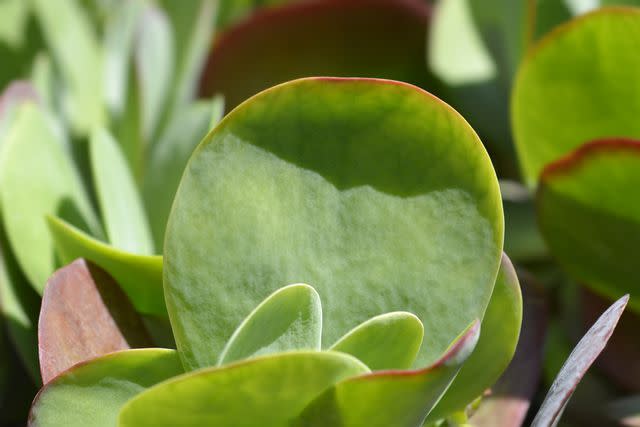
Nahhan / Getty Images
Because of the paddle- or clam-like shape of its leaves, this plant is also known as the paddle plant. It can be grown as a houseplant or outdoors, growing 1 to 2 feet tall and spreading in wide rosette clusters of 2 to 3 feet. It is toxic to pets.
Name: Flapjack (Kalanchoe luciae)
USDA zone: 9-11
Light: Full to partial sun
Soil: Loamy, sandy, well-drained
Water Needs: Low
Flaming Katy

Veena Nair / Getty Images
Its repeated bloom is one of the reasons why this is a popular houseplant, which is on the smaller size with 6 to 18 inches in height and width. The flower clusters extend above the scallop-shaped leaves. It is toxic to pets.
Name: Flaming Katy (Kalanchoe blossfeldiana)
Light: Bright natural light
Water Needs: Low
Ponytail Palm
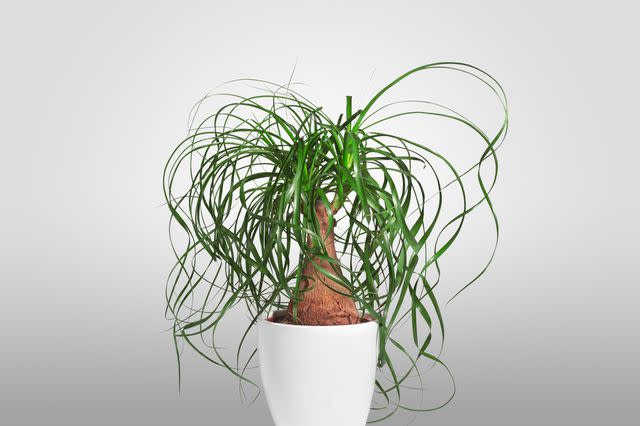
SzB / Getty Images
The tuft of strappy green leaves emerging from a bulbous stem makes this look like a palm but it’s a succulent that can be grown outdoors or indoors, where is stays much smaller, about 6 to 8 feet in height.
Name: Ponytail palm (Beaucarnea recurvata)
USDA zone: 10-11
Light: Full sun, bright indirect light indoors
Soil: Sandy, well-drained
Water Needs: Low
Snake Plant

Adam Yee / Getty Images
Nearly indestructible is a common description used for this houseplant with stiff, sword-like leaves. It may reach up to 8 feet in height but it’s a slow grower. The plant is toxic to pets.
Name: Snake plant (Dracaena trifasciata)
Light: Indirect light with some direct sun
Water Needs: Low
Zebra Haworthia
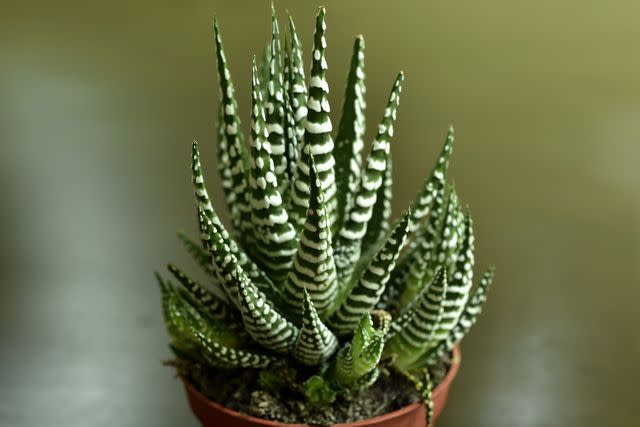
WhiteLacePhotography / Getty Images
The thick dark green leaves with horizontal white stripes gave this houseplant plant its name. Like most Haworthias, this is a small plant, reaching only 5 to 8 inches in height.
Name: Zebra haworthia (Haworthia fasciata)
Light: Bright light near an east- or west-facing window
Water Needs: Low
Mother of Thousands

Michele Cipriano / Getty Images
If you grow this plant, which got its name from the many baby plantlets that grow along the edges of its serrated leaves, as a houseplant, you might not see it bloom. Outdoors, it develops dangling pinkish-gray flowers after a few years. The mature size is 3 feet. The plant is toxic to pets.
Name: Mother of thousands (Kalanchoe daigremontiana)
USDA zone: 9-11
Light: Full sun, partial shade outdoors, indirect light indoors
Soil: Well-drained
Water Needs: Needs regular watering
Pink Quill

Tatiana Terekhina / Getty Images
This small houseplant—it only grows 10 inches tall—can be grown in a pot or as an air plant. Its large, long-lasting, showy pink bracts resemble ink quills. They start out pink and turn green over time.
Name: Pink quill (Tillandsia cyanea)
Light: Partial sun in east or west-facing window
Water Needs: Low
Ghost Plant

seven75 / Getty Images
In a warm climate, you can grow this low-growing succulent outdoors, otherwise as a potted houseplant. It has whiteish-grey pointed leaves and trailing rosette form, 6 to 12 inches tall. The rosettes take a blue-gray hue in partial shade or a pinkish-yellow tone in full sun.
Name: Ghost plant (Graptopetalum paraguayense)
USDA zone: 9-11
Light: Full to partial sun, south- or east-facing window
Soil: Sandy, well-drained
Water Needs: Low
Jelly Bean Succulents

Elizabeth Fernandez / Getty Images
When grown as a potted houseplant, this cute low-growing sedum that is native to Mexico is more contained than outdoors where it sprawls so it can be planted as a groundcover.
Name: Jelly bean succulents (Sedum rubrotinctum)
USDA zone: 9-11
Light: Full sun
Soil: Sandy, well-drained
Water Needs: Low
Living Stones

kazumi miyamoto / Getty Images
In warm climates, these ground-hugging succulents from Africa can be grown outdoors. In cold climates, plant them in pots so you bring them indoors for the winter. There are many different types of living stones, which all grow extremely slowly.
Name: Living stones (Lithops spp.)
USDA zone: 10-11
Light: Full sun
Soil: Sandy, well-drained
Water Needs: Low
Hens and Chicks

Maksims Grigorjevs / Getty Images
One of the hardiest succulents, hens and chicks can be planted outdoors in a wide climate range. They also make good potting plants, but there is no need to bring them indoors for the winter.
Name: Hens and chicks (Sempervivum tectorum)
USDA zone: 3-11
Light: Full sun
Soil: Sandy, well-drained
Water Needs: Low
Parry’s Agave
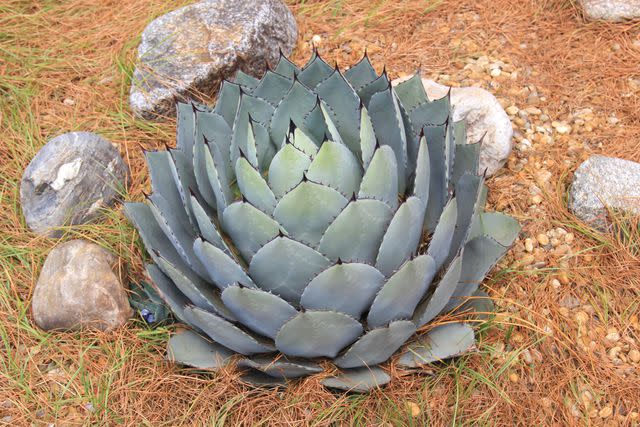
sigurcamp / Getty Images
This handsome agave for outdoor settings has slate gray-bluish rosettes. It has a clump-forming growth habit and grows up to 3 feet in height. The flower stalk reaches up to 20 feet in height.
Name: Parry’s agave (Agave parryi)
USDA zone: 7-10
Light: Full sun
Soil: Sandy, loamy, well-drained
Water Needs: Moderate
Propeller Plant

DESIGNOSAURUS / Getty Images
While other Senecio varieties are not cold-hardy, this type is able to handle some frost. It has bluish, flattened leaves on an upright plant that grows 18 to 24 inches tall and wide.
Name: Propeller plant (Senecio crassissimus)
USDA zone: 10-11
Light: Full to partial sun
Soil: Sandy, well-drained
Water Needs: Low
Autumn Joy Stonecrop

By Eve Livesey / Getty Images
One of the most popular sedums for landscaping, this stonecrop (which was previously classified as a sedum) has gray-green, rounded, succulent-like leaves. The plant, which grows up to 2 feet tall, blooms in the late summer to fall with tiny, pink, star-shaped flowers.
Name: Autumn Joy stonecrop (Hylotelephium telephium ‘Autumn Joy’)
USDA zone: 3-9
Light: Full sun
Soil: Sandy, well-drained
Water Needs: Low
Angelina Stonecrop

speakingtomato / Getty Images
This groundcover sedum forms a low-growing mat with tiny yellow flowers throughout the summer. In the fall, the foliage turns an orange rust color. It can be grown in containers but it does not need to be overwintered indoors.
Name: Angelina stonecrop (Sedum rupestre 'Angelina')
USDA zone: 5-9
Light: Full to partial sun
Soil: Well-drained
Water Needs: Moderate
Hardy Ice Plant

Dee Carpenter Photography / Getty Images
The name is a bit misleading—most ice plants are warm-climate perennials. Hardy ice plant is a species at the more cold-hardy end of the spectrum. It grows only 3 to 6 inches tall and has magenta flowers.
Name: Hardy ice plant (Delosperma cooperi)
USDA zone: 6-10
Light: Full sun
Soil: Sandy, well-drained
Water Needs: Low
Eastern Prickly Pear

douglascraig / Getty Images
One of the most popular prickly pear species for outdoors is also one of the hardiest. Eastern prickly pear is a sprawling, ground-hugging cactus that grows up to 12 inches tall and wide. It produces yellow flowers with an orange or red center from May through July.
Name: Eastern prickly pear (Opuntia humifusa)
USDA zone: 4-9
Light: Full sun
Soil: Sandy, well-drained
Water Needs: Low
Giant Chalk Dudleya
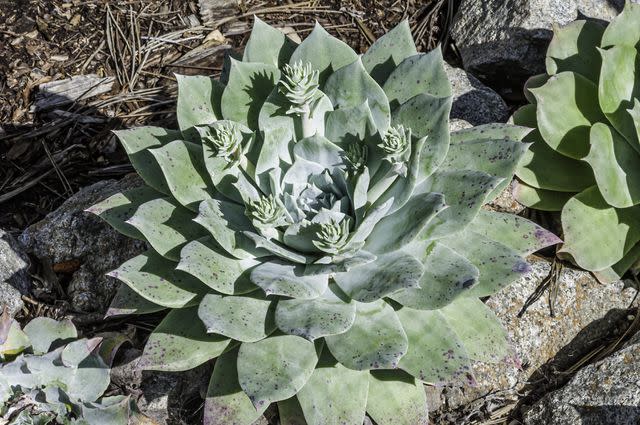
zhuclear / Getty Images
The 12- to 18-inch wide, whitish blue-green rosette is an eye catcher in any landscape. This is a non-branching Dudleya variety that produces a tall, vibrant red stalk and bright yellow flowers when in bloom.
Name: Giant chalk dudleya (Dudleya brittonii)
USDA zone: 9-10
Light: Full sun
Soil: Sandy, well-drained
Water Needs: Low
Tree Aeonium

Sundry Photography / Getty Images
With its bright green rosettes on a branching stem, the growth habit of this tall succulent is more like a shrub than a tree. In a warm climate, you can plant it outdoors where it will grow to about 6 feet. In colder climate, plant it in a container and overwinter it indoors. Potted plants max out at a height of about 3 feet.
Name: Tree aeonium (Aeonium arboretum)
USDA zone: 9-11
Light: Full sun to part shade
Soil: Sandy loam, well-drained
Water Needs: Moderate
African Milk Tree

Shapla Khatun / Getty Images
Although you can grow it as a houseplant, due to its vigorous growth (1 to 2 feet per year), an outdoor setting works better for this lush plant. It is toxic to humans and pets.
Name: African milk tree (Euphorbia trigona)
USDA zone: 9-11
Light: Partial sun
Soil: Loamy, well-drained
Water Needs: Low
Read Next: How to Repot Succulents in 6 Easy Steps, Plus When to Do It
Frequently Asked Questions
What are the most common succulents?
Succulents are very popular plants to start with because of their undemanding care. The most common types of succulents for indoors are aloe vera, snake plant, mother of thousands, jade plant, string of pearls, and agave. Common outdoor succulents in the landscape include agave, stonecrop (Sedum), hens and chicks, echeveria, and kalanchoe.
How often do I need to water a succulent?
The frequency of watering depends on the type of succulent, the sun exposure, whether it’s an indoor or outdoor plant, and other factors. It is unfortunately tempting to overwater a succulent. To avoid this, follow the rule of thumb for watering succulents and let the soil dry out to a certain degree between waterings. Learn how to read the signs when your succulent needs water.
Which succulents are the easiest to take care of?
Aloe vera, jade plant, hens and chicks, and the snake plant have a reputation for being especially easy to care for but there are many other no-fuss succulents. Generally, succulents that are grown for their foliage are easier to care for than succulents that are grown for their flowers.
Is it difficult to take care of succulents?
Succulents are so popular just because they require minimal care. They are very forgiving if you forget to water them. they need very little fertilizer and infrequent repotting, and they tolerate dry indoor environments in which the leaves of other plants turn brown. And even if a succulent shows signs of stress, it can often be revived.
Read the original article on The Spruce.
